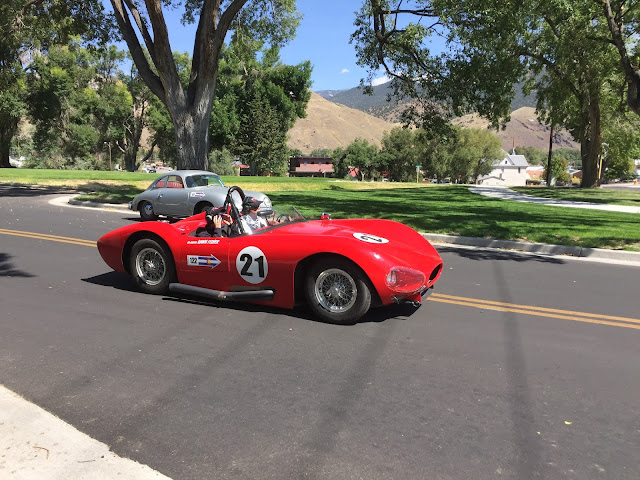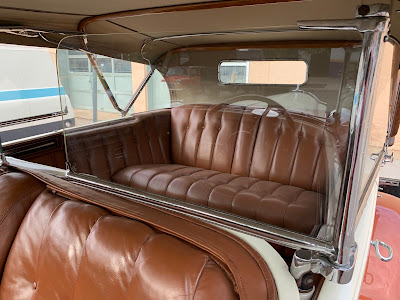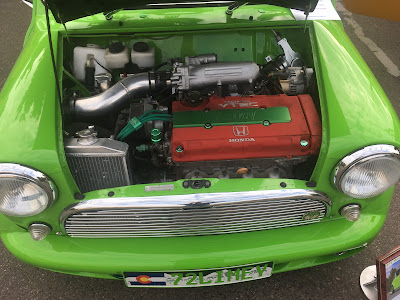A friend and contributor happened to be in the lofty Western Colorado towns of Gunnison and Salida when the Colorado Grand drifted through the mountain passes and stopped on shady side streets. It's an annual event benefitting Colorado charities, and winds through scenic mountain vistas, beginning and ending in Vail. Our friend* has a talent for being where the cars are, and this time he sent a trove of photos* beginning with the question, "What kind of Ferrari is this?"
Well, it appears to be a 340 / 375 Berlinetta Speciale bodied in 1953 by Pinin Farina. The alloy-paneled coupe was based on the 340 America which appeared in the beginning of the 50s as an answer to US Ferrari disrtibutor Luigi Chinetti's request for a big engine. Aurelio Lampredi designed a 4.1 liter V12 (each cylinder 340 cc) for sports and GT cars. Just over 2 dozen 340s were built and at least 4 were converted to 375 specs.; this is one of those. Lampredi's 4.5 liter (375 cc cylinders), engines followed the format of the earlier Colombo designs (sohc, aluminum block) but were made in two sizes, with the GP car under the 4.5 liter limit and the sports and road cars just a bit over. The shark-like nose was introduced after PF built the first 340 competition coupes with the oval grille from their 250 berlinettas. The Speciale looks like it could eat other cars for breakfast, and perhaps that's why the 250 GTO parked behind it seems to be trying to fade into the background. Only cars built in 1960 or earlier get to participate, so maybe the 1962-3 Series 1 GTO gets to play because it's nominally part of the 250 series which appeared in the Fifties. Anyway, that's what Enzo Ferrari wanted sanctioning bodies to believe when he tried to get the Gran Turismo Omologato, with its dry sump engine, new 5 speed transmission, and disc brakes, homologated as a production car.
The 340s and 375s were the most powerful cars sold to the public in this era, and were known as beasts to drive, with drum brakes and suspension design not up to the task of handling all the power. This body design set the theme for many of the Ferrari berlinettas that followed, including the more famous 250GT Tour de France. But it was unusual in having those Ford-like convex round tail light enclosures, a feature dropped on most later versions...
Zagato* was a pioneer in supplying lightweight bodywork for Alfa Romeos, and this example from the early Thirties exemplifies the coach builder's elemental approach; minimalism before the word was commonly used...
RIght-hand drive was standard fitment on upper crust Italian and French cars during this period, and facilitated racing on clockwise road courses like Le Mans, where Alfa Romeo won 4 times in a row from 1931 to 1934, all with the 8C-2300 series, the last time with future Ferrari dealer Luigi Chinetti co-driving…
The view below is the one that became tiresomely familiar to Alfa's competitors during this period. Duriing much of that time, the Alfa racing effort was managed by a guy named Enzo Ferrari.
The Nuvolari badge on this example may be a reference to one of its former pilots. During the decade of the Thirties, Tazio Nuvolari and Alfa Romeo made each other famous.
A Lancia Aurelia B20 from a couple decades later breezes through a shady lane as a happy passenger waves. The Aurelia was the product of Alfa Romeo's main rival in the Italian market, and appeared as a sedan in 1950 with the first production V6 engine. It was also a pioneer among front-engined cars in that its 4-speed transmission lived at the rear of the car for ideal weight distribution. Unlike the Ferrari 340 from the same era, the Aurelia founded a legend based on sweet handling...
In 1951 Pinin Farina started production of the Aurelia B20 coupe. Styling, however, has been credited to Mario Boano at Ghia, and it set the theme for a raft of what came to be called GT cars..
A silver Siata 208S spider and green 208CS coupe share an era with the Aurelias. They also share a 70 degree, 2 liter V8 with the Fiat 8V introduced in 1952. The 4-wheel independent suspension was as advanced as the Lancia's, cleverly adapted by Fiat engineers from a 4-wheel drive vehicle for the Italian army. Bodies for the spider were from Rocco Motto*...
…while the rounded contours on the CS coupe were designed and originally built at Stablimenti Farina (a firm headed by Pinin Farina's older brother), but were supplied by Balbo after Stablimenti Farina folded in 1953. Farina coupes and a lone spider have vertical grille bars, while most Balbo coupes have the grid shown. The retractable headlights were a very rare feature in 1953, a decade or more ahead of the mainstream curve.
An Aston Martin DB3S is not often seen in Colorado mountain towns, or anywhere, really. Aston built only 11 "works" racers to contend races in England and on the Continent, and 20 additional customer cars. One difference between the works and customer cars was the aluminum engine block on the factory team cars. The engine was the 3 liter twin-overhead cam Lagonda six, and suspension was by torsion bars with trailing arms front and rear, with a De Dion rear axle. Aston's engineers tried a twin-plug head on the later cars built during the car's 1953-'56 production run.
Frank Feely's body design on the short, 87" wheelbase chassis initially highlighted a flattened version of the DB2 grille with concave contours on the bonnet. The long arc of the front wheel arches became a signature of the car, and the smooth contours of Feely's design were a real improvement over the less aerodynamic lines on the car's unsuccessful predecessor, ex-Auto Union engineer Eberan von Eberhorst's DB3.
In a search for better aerodynamics to beat the Jaguars at Le Mans, Aston produced a fastback coupe version of the DB3S. Two works race versions were produced, but these proved unstable and crashed at Le Mans in '54; perhaps the lack of a Kamm tail and that typically British, too-vertical windshield were problems. Ironically, though Aston converted the works coupes back to roadster configuration, three customer racers were converted to coupes...
*Footnote: Special thanks to LCDR (belated congrats on the promotion) Jonathan Asbury for capturing these cars. Other examples of his work are on view throughout this blog. For more shots of the Siata 208 series, see "Sunday at the Races: Monterey Historics Part 2" (Aug. 29, 2018), and "Hillsborough Concours Part 1" (July 26, 2018). The 208 series and its sister car the Fiat 8V were given the retrospective treatment in "The Etceterini Files Part 10", posted Nov. 13, 2016. Rocco Motto's work is surveyed in "Unsung Genius: Rocco Motto, the Closer" (March 25, 2018). Zagato bodied Alfas are surveyed in "Body by Zagato Part 2: Five Decades of Alfa Romeos" (May 6, 2020). Finally, the founding of Aston Martin's road racing and James Bond legends is covered in "Rescued from Obscurity: Aston Martin in the Fifties and Sixties" (May 11, 2020).
Photo Credits: All color photos were generously provided by LCDR Jonathan D. Asbury, USN. Monochrome photos were sourced as follows:
Ferrari 340 / 375 Speciale: mad4wheels.com
Aston Martin DB3S coupe and late model: Wikimedia
Bocar: Bocar Mfg. Co.





















































